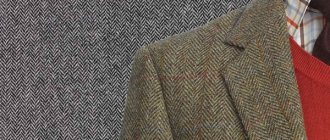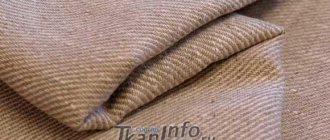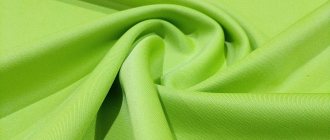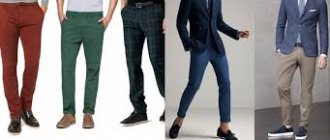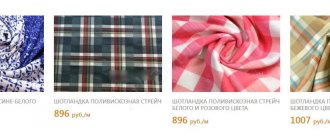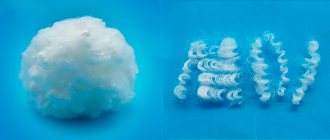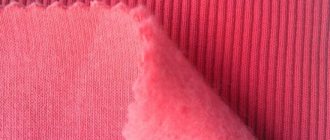You need to choose clothes for sports carefully. It must be hygienic, but at the same time durable. The best fabric for sportswear is knitwear with the addition of cotton or viscose. In second place is diving.
Of course, when choosing, it is important to take into account the type of sport. For yoga, running, and acrobatics, uniforms are made from the most elastic, wear-resistant materials. Climbers and skiers need uniforms that keep them warm. Tracksuits for everyday wear can be made from footer, velor and other soft and comfortable fabrics.
Requirements for fabrics for sportswear
A tracksuit should be comfortable and not restrict movement, so the fabric from which it is made has quite serious requirements:
- breathability. The material should not “float” the body, but allow the skin to breathe freely;
- hygroscopicity. When playing sports, sweat should be absorbed into the fabric and not accumulate under it;
- heat exchange. Clothing should provide good ventilation, protecting the body from overheating;
- safety. The material should not emit substances harmful to the body that can cause skin irritation and allergies;
- wear resistance. The fabric must be resistant to abrasion and other stress;
- practicality. Caring for a suit doesn’t have to be complicated or painstaking.
In addition, some types of sportswear designed for cold seasons need to be water-repellent and windproof, as well as be warm and lightweight.
The external attractiveness of the material from which the suit is made also plays an important role: performing exercises in a beautiful, bright sports uniform is much more pleasant.
Natural or synthetic?
There is no doubt that natural materials - cotton, linen, wool - are more preferable for sportswear, since they have a number of undeniable advantages:
- absorb moisture well;
- provide oxygen access to the skin;
- do not cause allergies.
But at the same time, natural fibers do not have sufficient elasticity and quickly lose their original appearance due to frequent washing. In addition, natural fabrics wrinkle a lot and require constant ironing.
Synthetic materials: polyester, polyamide, elastane - are characterized by other properties:
- increased strength;
- elasticity and extensibility;
- crease resistance;
- maintaining shape;
- durability;
- ease of care.
However, synthetics do not allow air to pass through well and can “float” the body, causing irritation and redness of the skin.
That is why manufacturers of fabrics for sports suits prefer to use mixed fibers that combine all the positive qualities of natural and synthetic threads.
Interesting fact! The famous specialists have been working for a long time to create comfortable fabric for athletes working with maximum loads. The result of their research was a micromesh made of polyester with the addition of natural silk, which instantly absorbs excess moisture, brings it to the surface and immediately evaporates.
The most common fabrics from which sportswear is made include knitted fabrics: soft and warm footer and elastic diving.
Footer: comfort with fleece
Footer is such a cozy, comfortable and hygienic knitwear that you can use it to sew clothes even for newborn children. Its front side is smooth and silky, and the back side has a pleasant bouffant texture.
To produce the footer, cotton fiber is used, to which polyester and elastane are added for strength and elasticity.
Types of footer
Depending on the number of threads that are involved in the process of creating the fabric, the footer is divided into three types, differing in strength and some other properties:
- Single thread is the thinnest, produced without the addition of synthetics. Light, soft and absolutely harmless material is used to make children's clothing.
- Double-strand - differs from the previous one in greater strength due to the addition of polyester fibers. The wrong side consists of many small loops, which made it possible to give the material a second name - loop footer. Robes, pajamas and other warm clothes for children and adults are made from this material. Double-thread footer is a fabric from which you can sew an inexpensive and comfortable sports suit.
- Three-thread is the densest and heaviest material, on the back side of which there is a thick pile. A very soft, warm and cozy fabric, for the production of which not only synthetic, but also wool fibers are added to cotton. Three-thread yarn is used for sewing insulated tracksuits and outerwear.
Interesting fact! The most unusual type of brushed footer is melange, all three threads of which are slightly different in shade. This fabric not only has a beautiful appearance, but is also very practical - it is easy to wash and dries quickly, which is very important for fitness clothing.
Properties of lining fabrics
For outdoor sports, especially in cool weather, it is best to choose suits made of two-thread or three-thread footer. The soft, delicate pile pleasantly warms the body without creating a “greenhouse effect” and perfectly absorbs excess moisture. In addition, the footer has other positive aspects:
- environmental friendliness. Since the material consists of 80% natural raw materials, it does not cause allergic reactions and can be successfully used for children's clothing;
- breathability. Even with fleece, the fabric perfectly allows air to pass through and the body under it “breathes” freely;
- dimensional stability. Clothing made from footer retains its shape after numerous washes;
- wear resistance. There are no puffs, pilling or abrasions on the fabric;
- resistance to pollution. Footer is a non-staining material that hardly gets dirty.
The only disadvantage of lining fabrics is their intolerance to direct sunlight, under the influence of which they begin to “creep” and lose the brightness of their colors.
Caring for sportswear made from footer
To ensure that sportswear made from cotton jersey retains its original appearance for as long as possible, you should follow the basic rules for caring for it:
- The water temperature for washing should not be higher than 400C.
- For products with fleece, it is better to use special liquid products rather than powders.
- Thick and heavy items should be wrung out in a towel after washing and then laid out horizontally until completely dry.
- Thin items can be twisted and hung on hangers.
- Do not dry knitted clothing on radiators or in bright sun.
- If there are no special instructions on the label, then ironing can be carried out by setting the regulator to the “cotton” position.
It is important to know! When purchasing a tracksuit made from footer, you should pay special attention to the quality of the inside . It often happens that manufacturers, trying in every possible way to reduce the cost of the product, instead of real fleece, glue a layer of cotton wool to thin knitwear, which will disappear after the first wash.
How to choose: useful tips
When choosing clothes, you should pay attention to several nuances:
- It should be comfortable to move and exercise in: squatting, jumping, stretching;
- It is better to stick to mixed fabric;
The comfort of wearing it depends on the right choice of clothing.
- When choosing a futen suit, it is important to consider the reverse side: to reduce the cost, some manufacturers glue a thin layer of cotton wool instead of fleece, which will disappear after the first wash;
- When choosing winter models, you should pay attention to the temperature regime, and also read reviews in advance: a suit designed for European temperatures of -10-15 degrees may not withstand the Russian winter.
You might be interested in Description of PU (polyurethane) leather: is it artificial or natural
Increased requirements apply to sports fabrics. They must be wear-resistant and durable, retain their appearance even with frequent washing and not fade, be breathable and absorb moisture. In addition, they should be pleasant and comfortable to work in.
Diving – elastic beauty
Diving is a fabric that was specially developed for the production of sportswear. It’s not without reason that experts call it “sports jersey.”
The basis for this textile is artificial viscose fibers, making up 50 to 70% of the total volume. In addition to them there are polyester and elastane, thanks to which the material is characterized by increased strength, elasticity and stretchability. Therefore, another name for diving is widely known – “second skin”.
Diving has two main types:
- Microdiving is a light and thin elastic knitted fabric. It is used to make sports swimsuits and clothing for swimmers, track and field athletes and gymnasts.
- Diving crepe is a denser fabric that has increased strength due to its highly twisted fibers. Used for sewing leggings, leggings and suits for automobile, parachute, cycling and other sports.
Interesting to know! The world-famous company produces tracksuits made from fabric called “superelastic”. This knitted fabric consists of 100% polyester fibers and is distinguished by the fact that it has a smooth front side and a fleecy back. Superelastic suits are warm, practical and very durable - they are successfully worn by athletes at various competitions.
Advantages and disadvantages
Thanks to the combination of viscose and synthetic fibers, diving has many positive properties:
- waterproof - moisture is not absorbed, but flows over the surface of the material;
- elasticity – diving has increased stretching ability;
- crease resistance - the fabric does not wrinkle and does not require ironing;
- wear resistance - the material is impervious to abrasions, tightening and other mechanical damage;
- ease of cutting and sewing - it fits tightly to the body, so it does not require darts or other adjustments to the figure;
- Easy to care for - the fabric is easy to wash and dries quickly.
However, it is not recommended for people prone to allergies to wear diving clothing, as under certain conditions the material can cause skin irritation.
And although the main raw material - viscose - is not synthetic, diving cannot be called a completely “breathable” material. Therefore, it is not suitable as casual sportswear.
Diving care: it couldn't be simpler
The ease of care for “sports jersey” is its undoubted advantage.
- Can be washed by hand or in a machine at a temperature not exceeding 300C.
- There is no need to wring out - just hang the clothes so that the water drains.
- Since diving is wrinkle-resistant, there is no need for ironing.
The wide range of colors inherent in this knitwear allows you to sew a variety of clothes for sports and fitness from it.
In addition to footer and diving, the following are also used for sewing suits:
- Dazel - fabric made of 100% polyester, very durable, elastic and wear-resistant;
- Duspo is a lightweight material with increased windproof ability;
- polytafetta - fabric with a water-repellent effect;
- mesh is a knitted fabric with a cellular structure, used as a lining material in clothing for sports and tourism.
The range of modern natural, artificial and synthetic fabrics allows you to choose a material for a tracksuit that can fully satisfy the needs of the most demanding lovers of active movement.
Questions and answers
Question: What fabric is ideal for a tracksuit?
Answer: For everyday wear and home workouts, knitwear with a high cotton content is best. Such clothes are not very durable, but they are hygienic, comfortable and affordable. For regular workouts in the gym, you should take a closer look at leggings and tops made of diving or other fabric with a predominance of polyester.
Question: Can sportswear be made from pure cotton or other natural materials?
Answer: Yes. The lack of elasticity can be compensated for by a special cut. For example, kimonos and obi are made from natural fabrics. It is also possible to play sports in the classic model of cotton Afghani pants.
When choosing which fabric to purchase or sew sportswear from, you should consider the type of activity. Some materials are suitable for training in the gym, but completely different ones for CrossFit on the street. Sports direction is of fundamental importance. After this, the material is tested. Then the new sports kit will certainly please you and bring only positive emotions and victories!
